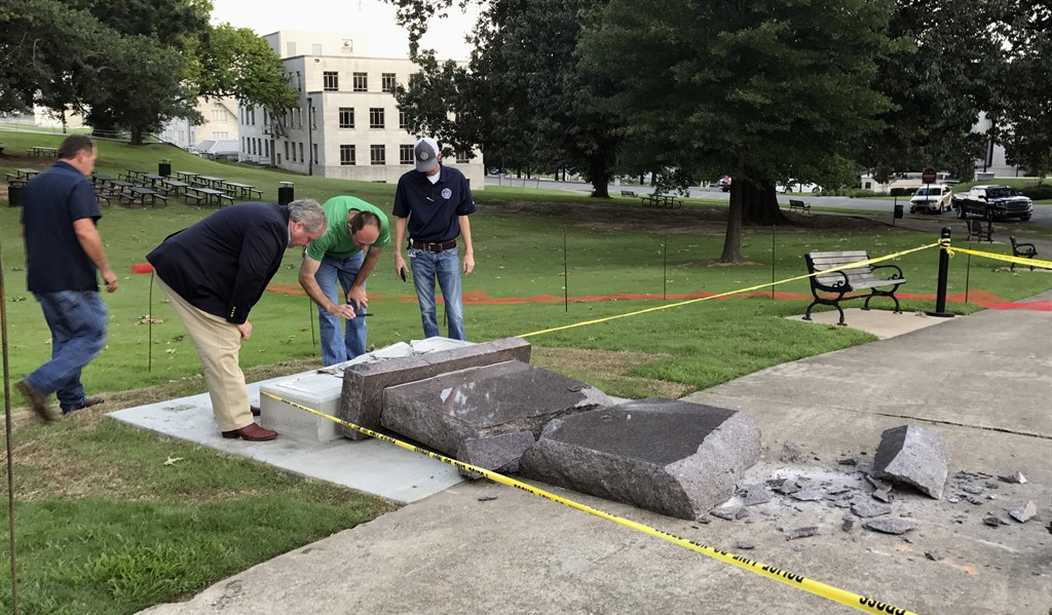Call off the ACLU, at least for now. The state of Arkansas installed a monument to the Ten Commandments on its Capitol grounds on Tuesday, after a controversial two-year battle over the nature of the First Amendment. The ACLU had planned to sue the state over the monument, but someone else took more direct action … with their car:
A 6-foot-tall stone Ten Commandments monument installed Tuesday on the Arkansas Capitol grounds was toppled less than 24 hours later after a 32-year-old Arkansas man drove a vehicle into the statue, police said.
Chris Powell, a spokesman with the Secretary of State’s Office, said he was called early Tuesday and told a man drove a vehicle through the monument. That driver — identified in an arrest report as Michael Tate Reed of Van Buren — was arrested by Capitol police shortly after, Powell said. Investigators believe Reed recorded himself as he drove into the statue, Powell added.
The arrest report said an officer around 4:45 a.m. spotted a dark-colored vehicle “start from a stopped position and ram the Ten Commandments monument.”
“I immediately exited my vehicle and placed the subject in custody,” Corporal Chad Durham wrote, noting Reed was first taken to a local hospital before being booked into the Pulaski County jail.
Here’s the video of the installation yesterday:
And the aftermath this morning:
Capitol crews sweep up remnants of the shattered 10 Commandments monument, toppled by a driver who is now in police custody #ARnews #arpx pic.twitter.com/97D4om0ER0
— Emma Pettit (@EmmaJanePettit) June 28, 2017
In Exodus 32, Moses broke the tablets himself in anger, and the Lord provided new tablets for the commandments in Exodus 34. It may take a little longer for the state of Arkansas to get another tablet for their monument. Although it was installed on Capitol grounds, it didn’t get state funds; the law passed by state senator Jason Rapert (R) only allowed for its placement. Over $26,000 was raised from private sources to produce and install the monument, which seems like a bargain when seeing the final monument — in its pre-broken state, that is. Backers will have to raise the funds again, and donors might be a little more skittish the second time around.
The ACLU lawsuit was pretty much de rigueur for the group. They lost a similar battle in 2005 when they tried to get a Ten Commandments monument removed from the capital in Texas, although as Yahoo News points out, the context was somewhat different; the monument there had additional historic value. However, the specific finding in the controlling plurality opinion from then-Chief Justice William Rehnquist in Van Orden v Perry reflected the historical nature of the commandments themselves as they related to the evolution of secular laws, rather than to the physical monument:
This case, moreover, is distinguishable from instances where the Court has found Ten Commandments displays impermissible. The display is not on the grounds of a public school, where, given the impressionability of the young, government must exercise particular care in separating church and state. See, e.g., Weisman,449 U. S. 39 (1980) (per curiam). This case also differs from McCreary County, where the short (and stormy) history of the courthouse Commandments’ displays demonstrates the substantially religious objectives of those who mounted them, and the effect of this readily apparent objective upon those who view them. See, post, at 21-25 (opinion of the Court). That history there indicates a governmental effort substantially to promote religion, not simply an effort primarily to reflect, historically, the secular impact of a religiously inspired document. And, in today’s world, in a Nation of so many different religious and comparable nonreligious fundamental beliefs, a more contemporary state effort to focus attention upon a religious text is certainly likely to prove divisive in a way that this longstanding, pre-existing monument has not.
For these reasons, I believe that the Texas display–serving a mixed but primarily nonreligious purpose, not primarily “advanc[ing]” or “inhibit[ing] religion,” and not creating an “excessive government entanglement with religion,”–might satisfy this Court’s more formal Establishment Clause tests. Lemon, 403 U. S., at 612-613 (internal quotation marks omitted); see also Capitol Square, 515 U. S., at 773-783 (O’Connor, J., concurring in part and concurring in judgment). But, as I have said, in reaching the conclusion that the Texas display falls on the permissible side of the constitutional line, I rely less upon a literal application of any particular test than upon consideration of the basic purposes of the First Amendment’s Religion Clauses themselves. This display has stood apparently uncontested for nearly two generations. That experience helps us understand that as a practical matter of degree this display is unlikely to prove divisive. And this matter of degree is, I believe, critical in a borderline case such as this one.
Would this case have fit the Van Orden test? It seems at least somewhat likely that this particular court would have found a bare majority in favor of it. Of course, we won’t know unless the monument gets replaced and the ACLU follows through on its challenge. That’s a lot more interesting than having a nutcase take the law into his own hands and destroy the monument, for which the state of Arkansas will hopefully deliver a just punishment that will serve as a warning to others similarly inclined. Or maybe they can post a barrier in front the next time, with the words Thou shalt not destroy that which is not yours carved into it.








Join the conversation as a VIP Member